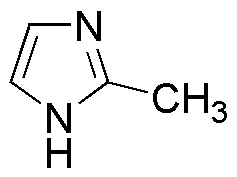2-Methylimidazole is widely utilized in research focused on:
- Pharmaceuticals: It serves as a key building block in the synthesis of various drugs, particularly in the development of antifungal agents and other therapeutic compounds.
- Corrosion Inhibitors: This compound is effective in formulating corrosion inhibitors for metals, especially in the automotive and aerospace industries, enhancing the longevity of components.
- Catalysts: In organic synthesis, it acts as a catalyst in various reactions, improving efficiency and yield, which is particularly beneficial in the production of fine chemicals.
- Polymer Chemistry: Used in the production of polyurethanes and other polymers, it contributes to improved mechanical properties and thermal stability of materials.
- Biotechnology: It plays a role in enzyme stabilization and in the development of biosensors, aiding in more accurate and efficient biological assays.
General Information
Properties
Safety and Regulations
Applications
2-Methylimidazole is widely utilized in research focused on:
- Pharmaceuticals: It serves as a key building block in the synthesis of various drugs, particularly in the development of antifungal agents and other therapeutic compounds.
- Corrosion Inhibitors: This compound is effective in formulating corrosion inhibitors for metals, especially in the automotive and aerospace industries, enhancing the longevity of components.
- Catalysts: In organic synthesis, it acts as a catalyst in various reactions, improving efficiency and yield, which is particularly beneficial in the production of fine chemicals.
- Polymer Chemistry: Used in the production of polyurethanes and other polymers, it contributes to improved mechanical properties and thermal stability of materials.
- Biotechnology: It plays a role in enzyme stabilization and in the development of biosensors, aiding in more accurate and efficient biological assays.
Documents
Safety Data Sheets (SDS)
The SDS provides comprehensive safety information on handling, storage, and disposal of the product.
Product Specification (PS)
The PS provides a comprehensive breakdown of the product’s properties, including chemical composition, physical state, purity, and storage requirements. It also details acceptable quality ranges and the product's intended applications.
Certificates of Analysis (COA)
Search for Certificates of Analysis (COA) by entering the products Lot Number. Lot and Batch Numbers can be found on a product’s label following the words ‘Lot’ or ‘Batch’.
*Catalog Number
*Lot Number
Certificates Of Origin (COO)
This COO confirms the country where the product was manufactured, and also details the materials and components used in it and whether it is derived from natural, synthetic, or other specific sources. This certificate may be required for customs, trade, and regulatory compliance.
*Catalog Number
*Lot Number
Safety Data Sheets (SDS)
The SDS provides comprehensive safety information on handling, storage, and disposal of the product.
DownloadProduct Specification (PS)
The PS provides a comprehensive breakdown of the product’s properties, including chemical composition, physical state, purity, and storage requirements. It also details acceptable quality ranges and the product's intended applications.
DownloadCertificates of Analysis (COA)
Search for Certificates of Analysis (COA) by entering the products Lot Number. Lot and Batch Numbers can be found on a product’s label following the words ‘Lot’ or ‘Batch’.
*Catalog Number
*Lot Number
Certificates Of Origin (COO)
This COO confirms the country where the product was manufactured, and also details the materials and components used in it and whether it is derived from natural, synthetic, or other specific sources. This certificate may be required for customs, trade, and regulatory compliance.


